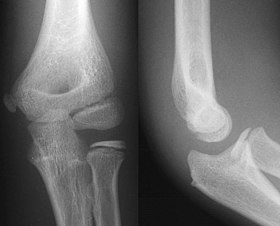Projectional radiograph
| Projectional radiography | |
|---|---|

AP and Lateral Elbow X-Ray
|
|
| ICD-10-PCS | B?0 |
| ICD-9-CM | 87 |
| OPS-301 code | 3-10...3-13 |
Projectional radiography is a form of medical imaging that produces two-dimensional images by x-ray radiation. Radiographic exams are typically performed by radiographers, who are trained, licensed medical professionals. However, radiographers generally perform other types of medical imaging as well, such as computed tomography, which also uses X-rays but generates axial sections of the body instead of projections.
Projectional radiographs are generally use X-rays created by X-ray generators, which generate X-rays from X-ray tubes.
A Bucky-Potter grid may be placed between the patient and the detector to reduce the quantity of scattered x-rays that reach the detector. This improves the contrast resolution of the image, but also increases radiation exposure for the patient.
Detectors can be divided into two major categories: imaging detectors (such as photographic plates and X-ray film (photographic film), now mostly replaced by various digitizing devices like image plates or flat panel detectors) and dose measurement devices (such as ionization chambers, Geiger counters, and dosimeters used to measure the local radiation exposure, dose, and/or dose rate, for example, for verifying that radiation protection equipment and procedures are effective on an ongoing basis).
Lead is the main material used by radiography personnel for shielding against scattered X-rays.
...
Wikipedia
